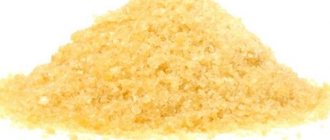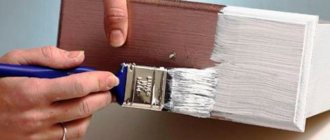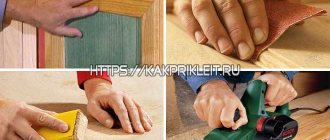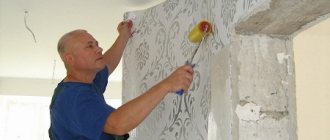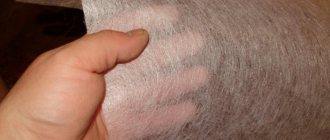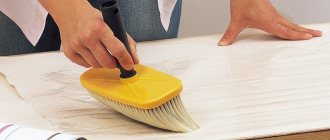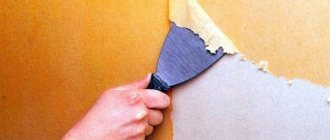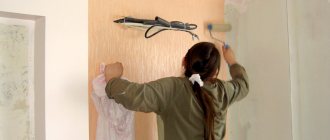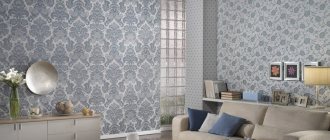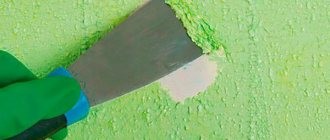Many people know situations when a child creates artistic masterpieces on wallpaper with colored pencils, school crayons, or even pens. Women sometimes manage to stain the wall with lipstick, mascara, eyelash glue, spill coffee on the wallpaper... Completely replacing wallpaper is an expensive undertaking. Therefore, see how to wash wallpaper yourself, without the need for repairs.
Nuances and features
It is best to remove stains and other contaminants using chemicals.
But the problem is that not every coating can withstand their aggressive effects. After such treatment, paper wallpaper can not only deteriorate, but also come off.
Chemical compositions are more suitable for vinyl and non-woven types of coverings. Before you wash your wallpaper from dirt, you need to remember a few important signs:
- A square with one wave indicates that washing with water is not acceptable. To remove dust, you can use a slightly damp cloth.
- A pattern in the form of two waves indicates that the coating can be washed with soapy water. But you shouldn’t get the wall too wet either.
- The three-wave designation allows the use of any type of chemical. These types of coatings are resistant to moisture.
- Waves with a crest indicate a super-resistant coating. During cleaning, you can use a washing vacuum cleaner and brush. The price for such products is quite high, but you don’t have to worry about the condition of the wallpaper when washing it.
How to wash washable wallpaper
Removing dirt with a sponge
Vinyl is a type of washable wallpaper. Wallpaper made on a paper basis, but coated with a special varnish that does not allow water to pass through, is also considered washable.
Wet wiping of such products requires great care and is carried out in compliance with the following rules:
- Prepare a cleaning solution as for non-woven wallpaper.
- Lightly moisten the sponge, cloth, microfiber, and apply a small amount of foam.
- Without applying much pressure to the wall, blot the wallpaper with a sponge.
- Remove excess moisture with a dry cloth.
Tests should first be carried out in a separate area. If it was not possible to wash off all the dirt the first time, repeated cleaning begins only after the material has completely dried. Otherwise, there is a high probability of damage to the outer layer and destruction of the paper layer.
Refresh the walls in the house
Wallpaper should not be washed too often. If they are not heavily soiled, simply refreshing them is enough. In this case, ordinary baking soda will have a good cleaning effect. We prepare this cleaning product as follows: dilute it in 1 liter. water approximately 30 grams of soda. Moisten a clean cloth with the resulting solution and wipe the walls - they will become much cleaner. How to wash washable wallpaper? Try to do this with soft, smooth movements.
It is possible to clean the walls well using a regular soap solution. It is made from water and soap in a ratio of 10:1. You can use liquid dishwashing detergent instead of soap.
I wash vinyl sheets in the same way.
How to wash washable wallpaper or covered with vinyl - soapy water or soda - choose for yourself. These methods are good if the contamination is insignificant.
How to clean dirt?
Before you begin removing dirt from the wallpaper, you need to determine the type of dirt, select the appropriate cleaning agent and make sure that the wallpaper can be washed. Cleaning wallpaper is possible using different methods:
- soda;
- soapy water;
- melamine sponge;
- special means for washing dishes, removing dust and stains;
- eraser;
- bread;
- chlorine bleach;
- talc;
- citric acid;
- alcohol.
If you are not sure about the resistance of the wallpaper to moisture and the chosen cleaning agent, you should blot a small piece of the coating; if there are no drips left, the surface has not deteriorated, the pattern has not changed - the wallpaper can be washed.
Classification of washable wallpaper
Conventionally classic wallpaper that can withstand wet cleaning can be divided into several types:
- paper, thin wallpaper made of paper, coated with a special moisture-resistant varnish, most often used in kitchens and hallways,
- vinyl, kitchen-themed wallpaper, material foamed and fixed with inhibitors, soft and pleasant to the touch,
- silk-screen printing, very strong and thin vinyl with added fabric fibers,
- Hot-stamped vinyl on a non-woven backing, usually in long, meter-long rolls that can withstand very harsh washing.
Paintable wallpaper, liquid wallpaper, metal, wood and other non-standard moisture-resistant types of wallpaper can also be washed.
Vinyl washable wallpaper with a kitchen theme
As dust and dirt accumulate on the wallpaper, the time comes for decisive action; now, armed with cleaning products, cleaning and washing operations are carried out.
But not all cleaning products can be used; there are certain nuances for different types of wallpaper, which will be discussed.
How to wash paper wallpaper
Wet cleaning of paper wallpaper is contraindicated.
Wet cleaning is contraindicated for such products. Water has a destructive effect on paper. To remove dirt, use a brush or eraser.
Advice! The dirt can be covered up with a decorative element that matches the interior or the problem area can be covered with new wallpaper.
Review of traditional methods of washing wallpaper
Professional products are expensive. It is more economical to use available means that are no less effective against stains.
Traditional methods have been tested by experience and have proven themselves well. If you have doubts about use, do a test. Clean a small area in an invisible place - behind a sofa or closet.
If the wallpaper has not changed or peeled off, the method can be used on the entire canvas.
Cleaning methods depend on the nature of the contamination.
From greasy stains
Most often, greasy stains appear in the kitchen. Food cooked on gas stains the wallpaper due to steam and splashes.
Talc, baby powder, and starch will help remove greasy stains. You need to act according to the instructions:
- Cover the floor to protect the flooring.
- Place a small amount of powder on a rag or sponge and apply talcum powder to greasy stains.
- After 15 minutes, the powder is removed with a dry sponge.
- If the stains are not removed the first time, apply a cloth and heat it with an iron, so the dirt is removed faster and more efficiently.
You can try using only an iron. Make sure that the canvas does not burn.
Set the iron to medium temperature and turn off the steam mode. 2-3 napkins are applied to the stain, and the heated sole of the iron is passed over them. There should be traces of grease stains on the paper. Change the wipes until the wall surface is as good as new.
For delicate paper wallpapers, you can use rye bread crumb. Press a piece onto the stains for a few minutes. Due to the gluten found in bread, dirt is absorbed from the surface of the bread. For best results, do the procedure twice.
A mushy mixture of gasoline and tooth powder will help remove old grease stains from the wallpaper. Mix gasoline and powder in a 1:1 ratio and apply the mixture to the stains. When dry, remove with a sponge.
A solution of baking soda will help remove grease stains. Dilute a little powder in warm clean water at the rate of 20 g per liter. Wring out the sponge soaked in the liquid, hold it on the surface and remove the dirt with rubbing movements.
An effective remedy in the fight against greasy stains is pure alcohol, solution or alcohol tincture. The main thing is that the liquid is transparent and does not leave any traces. You can spray it on the canvas or gently rub the stains with a cotton pad. Alcohol copes with grease, markers, felt-tip pens, traces of aerosol products, air fresheners, and mosquito sprays.
From soot, soot, tobacco smoke
Citric acid will help wash away the unpleasant yellowness from cigarettes and nicotine on the walls and ceiling of the room. Prepare an acid solution with heated water, and carefully treat the desired area with a cloth. For 1 glass you will need 3 tablespoons of powder. The sponge should be slightly damp; wring it out well.
Leave the dirt remover on the canvas for a few minutes and rinse off with a sponge rinsed in clean water. The product removes alcohol markers, marks from a ballpoint pen, and watercolor paint.
A vinegar solution will help remove soot, glue, and soot stains from wallpaper. Take 50 ml of table vinegar - 6%! - liter of water. Spray the solution on the walls, after five minutes wipe the finish with a damp sponge. It is better to clean with vinegar, protecting yourself with a respirator and opening the windows.
From mold
A solution with 9% vinegar is best. Spray it on the moldy area. Leave for 15-20 minutes. At this time, the mold spores die.
Wipe with a damp cloth or sponge.
Vinegar is used to prevent the spread of mold spores.
From food products
To remove traces of food, coffee and tea stains, use soapy water. Rub soap shavings and fill with warm water 1:10. Use a soapy sponge to moisten the dirt. Then it is wiped clean again so that no soap stains remain.
From ink and paint
A stationery eraser removes minor dirt and fingerprints.
A melamine sponge is a popular tool that removes traces of markers and ink. It has a hard abrasive part, you need to be careful with a wet wash so as not to deform the convex images on non-woven wallpaper. Try the method on a small area first.
For light surfaces, bleach is suitable. It dissolves in water and is transferred to the ink trace with a brush.
The felt-tip pen is washed off the walls with a solution: 100 ml of water, 10 g of oxalic acid, 10 g of citric acid. Dip a cotton swab or disk into the liquid and apply to the drawings.
To combat ink on wallpaper, you can use citric acid.
A hard-boiled egg will do. Cool, cut it and apply to the wallpaper for 5 minutes.
From organic pollution
Hydrogen peroxide is recommended for cleaning blood or vomit stains. It whitens and disinfects areas.
Wet a cosmetic pad or cotton swab. Wipe off the dirt with light movements. Residues are removed with a damp sponge.
Questionable methods
There are many more methods on the Internet that housewives recommend using. However, on various forums there are both negative reviews after using such tips, and mentions that they do not have the desired effect.
Before using the methods listed below, we advise you to try them either on remnants of wallpaper, if any, or on invisible areas of the wall.
Almost all methods relate to removing marks from a ballpoint or gel pen and are recommended only for vinyl wallpaper. Be sure to wear rubber gloves before working.
- №18. Potassium permanganate + vinegar. Add potassium permanganate to a small amount of 7% vinegar to make the solution a deep purple color. Dampen a cotton pad or cotton swab and apply to the area. After this, wipe the surface with a clean pad soaked in hydrogen peroxide. If the strokes from the pen are thin and single, then it is better to use a brush to reduce the area of exposure of the solution to the clean surface;
- №19. Dissolve 10 g of oxalic acid in 100 ml of clean water. Soak a sponge or cotton pad in the solution and wipe the outlined area;
- №20. Dissolve 1 tsp in 200 ml of water. table salt and 1 tbsp. of hydrochloric acid. Using a cotton swab, apply the product to the stain, and then wash off the residue with a damp soft cloth;
- №21. Dissolve 2 tsp in 100 ml of water. any detergent. Treat the area with the resulting soap solution until the ink disappears completely. To remove marks or stains, wipe the surface with a damp, clean cloth;
- №22. Dissolve 20 ml of white in 100 ml of warm water. This method is only used for white or very light wallpaper. Soak a sponge in the solution and treat the stain;
- №23. It is also recommended to remove stains on white surfaces using whitening toothpaste. A small amount of paste is applied to a soft toothbrush and the mark from the handle is treated. After this, let the paste dry and wipe off the residue with a dry cloth;
- №24. Soak a cotton pad in acetone-free nail polish remover and rub the ink. This method can only remove fresh marks from a ballpoint pen, felt-tip pen or marker;
- №25. To clean the surface of waterproof wallpaper, you can use a special ready-made product “Arenas exet 2”. They treat the dirt with it and leave it for 10 minutes, after which they wipe it with a dry cloth;
- №26. A slurry is prepared from 550 ml of warm water and 50 g of starch, which is applied to the ink and left until completely dry. Then remove the residue with a dry cloth;
- №27. A small amount of regular shaving foam is applied to the stain and allowed to dry, after which the surface is wiped with a dry cloth;
- №28. The yolk of a boiled chicken egg is applied to the mark of a ballpoint pen and wait until the product absorbs the ink;
- №29. Use a brush dipped in warm milk to treat the stain and let the milk dry completely. The spots should lighten and then disappear completely;
- №30. Grate a small amount of laundry soap and prepare a paste from it. Apply it to the surface of the wallpaper and wait until it dries completely. Repeat as necessary;
- №31. Using wet wipes, you can try to wipe off not only the pen mark, but also other stains.
The main reasons for wallpaper contamination
Children's creativity is one of the most common reasons why wallpaper gets dirty
Walls get dirty for various reasons. It can be:
- grease stains, paint;
- traces of writing objects: pen, felt-tip pen, pencil, ink;
- fingerprints;
- soot, soot;
- smoke due to tobacco;
- organic pollution;
- food stains.
Some stains can be removed by wiping them with a damp cloth. Others require more drastic measures, but chemicals can damage the coating. In such cases, the markings on the label will indicate the best cleaning methods.
What to do if nothing helps or things get worse?
It is possible that none of the above methods will help eliminate contamination without leaving a trace or will leave a characteristic imprint after its impact. And in some cases, you will have to abandon cleaning altogether. How, then, to remove the stain?
You'll have to resort to a trick:
- If the defect is at an acceptable height, you can decorate the place by hanging a beautiful picture, clock, wall shelf, etc. Of course, this method is not suitable if the stain is located near the floor or somewhere in the corner;
- Perhaps you can install a beautiful flower stand in the corner or hide the defect with another low piece of furniture;
- If we are talking about wallpaper for painting, then the defect can always be eliminated by re-painting. It is not necessary to paint the entire wall;
- Paper or fabric wallpaper can be partially replaced. Depending on the scale of the disaster, you can re-glue either the entire strip or half of it. Or just get by with a fragment of 10x10 cm. Therefore, you should never rush to throw away the remains of wallpaper - they may come in handy;
- If none of the methods suits you, think about it: maybe you shouldn’t try to mask marks from felt-tip pens or pencils? Select a small fragment on the wall, decorate its contours with a beautiful decorative baguette, and let your child use it as a canvas. After all, it will be a real memory.
Advantages and disadvantages
Such wallpaper is relatively new on the market, but this time was enough to appreciate all the advantages of non-woven wallpaper:
- maintaining dimensions after drying;
- increased density of the canvas, allowing you to hide cracks and unevenness on the wall;
- resistance to fire, smoldering and high temperatures;
- oxygen transmission;
- water resistance;
- maintainability;
- possibility of painting.
Separately, it should be noted such features of non-woven wallpaper as ease of gluing and leveling. When using non-woven wallpaper, glue must be applied only to the wall. This helps preserve the quality of the flooring, time and effort spent on repairs. Wallpaper can also be removed easily. Before removing non-woven wallpaper, you do not need to carry out any preparatory measures.
Non-woven wallpaper also has disadvantages:
- low resistance to dirt due to the porous structure and ability to collect dust;
- high cost relative to other types of wallpaper.
It is worth noting that these disadvantages are very insignificant relative to the advantages, which makes any non-woven wallpaper the most popular material for interior decoration. And if you know how to glue meter-long non-woven wallpaper, then soon the room will sparkle with new colors.
How to remove eyeliner from wallpaper. We wash wallpaper from dirt and plaque
Over time, stains of various origins appear on the wallpaper, which are difficult to clean. But modern chemicals and home remedies can help eliminate the stains.
How to remove dirt from wallpaper
Cleaning wallpaper from dirt is easy if you follow some rules.
- When carrying out repair work, preference is given to good finishing materials. Simple paper materials get dirty faster and it is more difficult to remove traces from them.
- Non-woven and vinyl products with a resistant coating are washed with a damp cloth. They do not absorb dust, dirt, or unpleasant odors; almost any type of contaminant is removed from their surfaces.
- Wallpaper is washed using various methods. Some people use special detergents for these purposes, others use soapy water or traditional methods.
- Be sure to carry out a preliminary test on wallpaper in invisible places: behind the sofa, in the corners. After checking, you need to see if the material is deteriorating from water or the selected product, and then further cleaning is carried out taking into account the result obtained.
To conduct testing, the surface is treated with a damp sponge with the selected product. If after the procedures the materials have not lost their texture, there are no streaks left on them, and they have not lost their rich, bright color when drying, further cleaning can be done. If they are deformed, the surface either cannot be washed, or you should try other detergents.
How to wash wallpaper? Folk remedies
First of all, you need to clean the wallpaper from dust using a vacuum cleaner with a soft brush or dry cloth. If you wash stains on a dusty surface, streaks will form on the walls.
- Soap solution. Vinyl and non-woven materials are washed with a solution using liquid soap or dishwashing detergent. Non-woven products are washed with clean warm water; vinyl products can only be washed with foaming agents. Paper - dry clean only. If the first wet treatment of the walls fails to remove stains and dirt, repeat the procedure after the surface has dried.
- Chlorine-based bleach will help lighten yellow stains and also remove heavy stains on light-colored wallpaper. Dirt must be removed with quick wetting movements so that the material does not become soggy from a large amount of liquid. After washing, carefully wipe the cleaning area with a dry soft cloth to remove excess moisture;
- Melamine sponge. It easily copes with stains on vinyl products, but can harm non-woven and paper products.
- Bread. This option is suitable for inexpensive paper products. Take a piece of soft bread and place it on the surface to be treated for a few minutes. The procedure is repeated several times in a row until the stain completely disappears.
- Gasoline, kerosene, alcohol. These substances remove not only greasy stains, but also paint, primer, and putty. They are used on any surface: paper, vinyl, non-woven.
- A mixture of gasoline and tooth powder will help deal with greasy stains that have formed in kitchens. The product is prepared in the same proportion, then applied to the stain. After drying, remove the residue with a brush.
- Vinyl and non-woven products can be easily cleaned with wet wipes. With this method, it is worth choosing products that do not contain various oils.
- Non-woven products can be cleaned with a mixture of water, soda or starch. The mixture is prepared in a ratio of 1:4 and applied to the stain. After drying, the remaining product is removed with a brush, and the cleaning area is wiped with a damp sponge.
How to wash vinyl wallpaper
To work you will need:
- sponge, microfiber, any material that the housewife can find at home, for example, cashmere, an old towel;
- delicate brush;
- liquid that does not contain acid and abrasive inclusions.
Preparation of the mixture:
- Add the product to a bowl of warm water. It must be infused in small doses. The concentration of the solution depends on the degree of contamination and the quality of the vinyl layer.
- Thoroughly dissolve all components.
- Achieve the formation of dense foam . For better results, you can use a mixer. Foam should not be saved when cleaning particularly contaminated areas.
The moisture resistance of the coating must be taken into account. Compact vinyl and silkscreen are considered the most durable. They can be cleaned even with a heavily moistened brush. Cleaning with a washing vacuum cleaner is also an available option.
Foamed ones require more careful care. Dirt from their surface is washed with a soft cloth slightly moistened in a weakly concentrated soap solution.
Before starting cleaning, you should conduct a test on the remnants of wallpaper or on a small, hidden area on the wall, and if the result is positive, begin to treat the entire area.
Washing methods
There are many ways to wash wallpaper. But in order to carry out cleaning correctly, when choosing a method, it is important to take into account the material from which the wall covering is made, since products used for washable wallpaper, etc., are not suitable for non-woven material.
Pollution
It is easier to remove ordinary dust from wallpaper than from a wall after painting. We wipe off dirt with a soft, dry cloth, preferably after using a vacuum cleaner, without excessive pressure.
If you have paper wall coverings in your home, clean them once a year with a soft flannel cloth lightly (!) moistened with alcohol. This will help get rid of not only dust, but also mold.
Important! The recommended cleaning method is indicated by the manufacturer in the form of marks and symbols.
Plaque, fat
How to remove grease stains and dirt from wax pencils (crayons) on the wall? If you have children who often create pictures on walls using wax crayons, this question is always relevant for you. The same applies to the walls in the kitchen, where you often have to deal with stains from grease, vegetable oil...
Grease stains can be removed by heating. Place an absorbent napkin or paper over the stain and heat it with an iron on top. The fat will melt and be absorbed into the napkin.
This method is suitable for removing plasticine. Remove the plasticine from the wall, then follow the procedure described above.
You can try the cleaning method using starch:
- Mix starch with water so that the mixture is quite dense - it should not flow off the wall.
- Wipe the stain and leave the mixture to dry.
- After drying, use an old toothbrush or other small brush to carefully remove the starch, the dirt will disappear.
The starch cleaning method is suitable for removing lipstick marks. This method can also eliminate small mold.
When using starch paste, be careful with the joints of the seams - try to avoid them so as not to soften them.
Stains
To remove stains, you can use yesterday's bread. It should not be too soft or too hard. Another option is white chalk.
First, remove dust and surface dirt from the walls. Take a small broom or, ideally, a vacuum cleaner with a soft brush. This will get rid of spiders, cobwebs, etc.
Cleaning with bread:
- Roll the bread crumb into a solid ball.
- Using light pressure, rub the ball over the stain on the wallpaper, as if erasing pencil marks on paper.
- Repeat the procedure, replacing the balls as necessary.
Cleaning stains with chalk:
- Take white chalk (it will not leave stains when removing dirt even from black walls), apply a thin layer to the dirt.
- Leave until the next day, then remove the chalk along with the stain.
Many cleaning assistants are hidden in a school pencil case. One of them is an eraser that can be used to erase a pencil. Clean carefully so as not to disturb the design or damage the surface.
Paint, ink
Denatured alcohol will help wash gouache, ballpoint pen, and marker from wallpaper. In some cases, this is the only method that can remove ink from walls. Moisten a cotton pad or swab with alcohol, wipe off traces of paint, handles.
A more modern method is to use a melamine sponge. It can remove almost any stain, but is not suitable for paper or fleece surfaces. Recommended for paintable, washable, vinyl wallpaper. A melamine sponge can remove soot and ink marks. It can be used to remove paint from vinyl. The tool will also help to clean wallpaper (eg textile) from glue.
Tobacco smoke
A vinegar solution (50 ml/1 liter of water) will help eliminate yellowness caused by tobacco smoke and clean old wallpaper. Pour the solution into a spray bottle and spray all walls.
It is recommended to wear a respirator and rubber gloves and open the windows.
Such cleaning will not only get rid of soot and dirt, but will also freshen the air in the apartment.
Color palette and combinations
Plain non-woven wallpapers are most often presented in not the brightest colors, although, of course, they can also be found in a palette of shades. This is explained by the fact that the structure of such materials is already expressive in itself, so a bright color, for example, green, is often unnecessary. If an exceptionally bright color is needed to implement a design idea, it is better to paint non-woven wallpaper.
Non-woven wallpaper in the interior can be very extravagant. If the wallpaper is green or a different color produced in Europe, for example, by emotional Italians, then in the palette of wallpaper for the ceiling for painting you can find a variety of color textures and patterns. Attention to detail is typical of Russian manufacturers. Their products meet design requirements, are easy to apply and last a long time.
As for fashion and design, deep colors and black and white shades are popular in the latest season, which can be used in any room when decorating all types of premises. Non-woven wallpaper with a pattern is not only beautiful, but also modern.
Correct cleaning order
To effectively clean wallpaper from dirt, you need to follow the sequence of actions.
Thus, it will be possible to avoid troubles associated with damage to the coating.
The work of cleaning the walls is divided into five points:
- You need to carefully vacuum the surface before wet cleaning. This is done so that the dirt does not spread over the entire area. Perhaps fulfilling this condition will be quite sufficient. If the wallpaper turns out to be clean without dust deposits, then washing will not be necessary. It is better to set the vacuum cleaner to minimum power so as not to wrinkle or tear the wallpaper.
- Fill a bucket or basin with warm water. Add dish soap, floor detergent or laundry detergent. Just don’t make the solution too soapy, as there will be a lot of unnecessary foam. This mixture is not suitable for painted wallpaper, because it will immediately wash off all the paint from it. It is advisable not to use simple powder. It leaves behind whitish stains, which will be difficult to remove later.
- Wet the sponge and squeeze lightly. Wipe the wallpaper quickly so that it does not get too wet or peel off. This applies to a greater extent to painted canvases. If the paint on them is not moisture-resistant, then washing them is prohibited. It is better to refresh the color with a new layer of coating.
- After cleaning the room, you need to close the windows and doors. If there is a draft, the wallpaper may swell or move away from the walls. Operating heaters should not be too close to the washed linens.
- Dirty paper wallpaper can be wiped with a slightly damp or dry soft cloth. If this does not help, all that remains is to replace them with new ones.
What wallpaper can be cleaned?
Before you begin to influence the coating in one way or another, you need to make sure that this type of wallpaper can be washed at all. Otherwise, instead of a small stroke from the pen, we will get a large white spot.
The necessary information is contained on the label located inside each roll. Make it a rule for the future that after each repair, save a small piece of new wallpaper, and attach a label to it using a stapler. You need to pay attention to the icons with wavy stripes, which indicate the degree of resistance of the surface to cleaning:
- One wavy stripe means that the surface can be wiped without pressure and without using detergents with a soft, damp cloth;
- Two wavy lines indicate the surface’s resistance to the effects of a soft sponge dipped in soapy water;
- Three stripes mean the possibility of long-term washing with a well-moistened sponge;
- One wavy line, a straight stripe and a ridge mean that the surface of the wallpaper can withstand wet cleaning with a brush or a vacuum cleaner;
- Three wavy lines, one straight and a comb. This marking is applied to the label of the most resistant wallpaper. They can even be rubbed with a brush and soapy water until foam forms.
We recommend that you strictly adhere to these recommendations. You also need to understand that even the most durable surfaces, if rubbed for a long time in the same place, can change color or lose their glossy shine.
How to clean heavy stains
In solving the question of how to wash wallpaper from dirt, ordinary home remedies available in every home can help.
If the wallpaper has a convex pattern or is heavily soiled, then you will have to resort to using household chemicals. Unfortunately, paper wallpaper or silk wallpaper cannot be cleaned from dirty, stubborn stains.
To effectively clean wallpaper, when choosing a cleaning product in a store, first read the instructions for that product. Make sure that the detergent is suitable for the coating that you have in your apartment or house. If the cleaning agent is used incorrectly, the wallpaper may be damaged. Typically, the manufacturer indicates which types of decorative fabrics the product affects too strongly and how to avoid this.
Wallpaper has different moisture resistance and tolerance to chemicals, this should be taken into account. Canvases for painting can only be washed if the paint is marked as moisture resistant. Otherwise, washing cannot be carried out.
How to clean mold from wallpaper?
You can remove it with the following cleaning agents:
- "Anti-mold".
- White solution.
Mold does not like treatment with chlorine and will disappear for a long time after such a procedure.
It is also worth having an idea of how to wash non-woven wallpaper. They usually tolerate wet cleaning well, but washing paper and carpet fabrics is not advisable. This wall covering can only be wiped with a clean and barely damp cloth.
Do not allow the dirt to become firmly embedded; try to remove fresh stains.
Grease stains can be removed using regular talc:
- Apply it to a clean lip or tissue.
- Gently wipe the surface.
- Leave the talc on for 15-20 minutes.
- Remove with a clean dry cloth.
If necessary, the procedure can be repeated. You can try to remove such a stain with a piece of bread. To clean, simply wipe the stain with the pulp; it will disappear.
Citric acid will help remove plaque on the walls:
- prepare a solution: add 2-3 tablespoons of citric acid to one glass of water and stir,
- wash the contaminated area with a sponge dipped in it and leave for a short time,
- wipe with a clean damp cloth.
This solution also removes dirt from an alcohol marker well.
Traces from splashes in the kitchen, from markers, and greasy stains are removed with alcohol. It will also remove residues from aerosol products.
Zelenka can be removed using hydrochloric acid. Wet a sponge with a 5% solution, apply to the stain and wipe. Of course, you have to be extremely careful with acid. Hands must be protected with gloves; do not forget to wear a mask; acid fumes, even at this concentration, are harmful.
To remove traces of blood, use hydrogen peroxide. When treating a stain, change cotton swabs frequently to avoid staining clean areas with blood.
Treat areas where wallpaper paste was carelessly left with vinegar. Fresh glue can be easily removed with plain clean water.
In any case, you need to wash the wallpaper very carefully, since the material is quite delicate. After any wet treatment, try to avoid drafts in the room to avoid peeling. When the wallpaper is washed, it should be lightly wiped with a dry cloth.
Little tricks
If you notice dust on the wallpaper, do not start wet cleaning. First, remove the dirt with a dry cloth. Otherwise, you'll just leave dirty marks on the wall.
Light stains can be removed with a regular student's eraser. But you need to act carefully so as not to rub off the top layer of the drawing.
Sometimes a regular one helps to clean the wallpaper. To do this, you need to turn on the device at minimum power and carefully, without getting too close, walk along the surface. This type of cleaning will help you get rid of stuck hairs, dust, small debris and more.
If you overdo it with water, apply a napkin folded in several layers to the soaked area. Porous paper will quickly absorb moisture. You can also try drying the wall with a hairdryer, but you need to switch it to a cold setting to avoid curling and deforming the wallpaper.
Many people wonder how to wash washable wallpaper in the kitchen if it gets grease on it. In order to do this, you should heat the moisture-resistant surface with an iron through a thin cloth.
Under the influence of heat, the stain appears on the surface, partially transferring to the fabric. Well, then you can process the vinyl in the usual way.
How do you know if your wallpaper can be washed?
If the wallpaper is washable, this will be indicated on the label. If there is no such information there, it means that your wallpaper cannot be wet cleaned. Still in doubt? Cut a small strip from the roll and check the reaction of the wallpaper to water on it.
Is it possible to wash non-woven wallpaper? This type of wallpaper is quite a popular material for decorative wall decoration. However, over time they become dirty and covered with dust. This article will tell you whether it is possible to wash non-woven wallpaper without the risk of harming it.
Non-woven wallpaper is a finishing material on a non-woven base, consisting of long cellulose fibers and polymers for bonding. Non-woven fabric increases the strength of paper wallpaper.
Advantages of the material:
- Air, water and vapor permeability, which allows the walls to “breathe”.
But when applied to non-woven vinyl, the wallpaper will no longer be breathable, and they are called “non-woven based”. - This type of material holds its shape well
, which allows it not to stretch after gluing the canvases, and not to shrink when drying.
Advice: To decorate apartments in new buildings, where the walls often shrink over time, you should stick non-woven wallpaper.
- Safety and environmental friendliness of non-woven wallpaper
, but in the absence of vinyl coatings on them. - They can be used for painting
. In this case, painted wallpaper only acquires a more durable structure. - They just stick on
. Wallpaper glue is applied directly to the walls, and the canvases themselves are not coated, which makes joining them easier. - Non-woven wallpaper can be used to cover any surface
:
- after plastering (see);
- concrete;
- gypsum cortone (see);
- made of wood;
- paper
It is important that the color of the surface matches the shade of the underlying layer of wallpaper. Otherwise, the dark base will appear from under the wallpaper. Non-woven fabrics can be used for finishing not very high-quality plastered walls with cracks. In addition, if there were no cracks before gluing, but then they appeared, the wallpaper will simply stretch, and the defects underneath will not be noticeable.
Non-woven wallpaper can be removed without much difficulty, if you want to change it. In this case, only the top, decorative layer is removed, which is easily removed and does not require soaking. In this case, the non-woven base will remain on the wall surface, which evens out and strengthens its texture.
The disadvantages of the material include:
- Clean non-woven wallpaper cannot be washed
. They are cleaned of dust with a vacuum cleaner. - High price.
- Despite the high density of the material, without preliminary impregnation with an adhesive composition they lose their plasticity
and will not stretch. Therefore, they should not be glued to walls with large defects. The material will not stick tightly to the wall and will need to be cut. - Non-woven fabric allows light to pass through.
Such washable wallpaper can only be glued to surfaces that have a neutral color. The best option is white walls, which will prevent the outlines of the previous pattern from appearing outward.
How are non-woven vinyl wallpapers labeled?
If non-woven wallpaper cannot be washed, then vinyl wallpaper with a non-woven base can be washed, and a special marking on the material indicates the washing method, and if in the square:
- One wave - such wallpaper does not like washing. They are carefully wiped with a damp cloth or sponge, without adding detergent to the water.
- Two waves. In this case, the canvas can be washed with the addition of a small amount of soap, but the cleaning operation must be carried out very carefully.
- Three waves. This is how the most durable and sufficiently wash-resistant materials are marked. They can be washed with the addition of any detergent.
- If there is a comb symbol in the square for marking, in addition to the waves, brushes and a washing vacuum cleaner can be used for such material.
Detergents
One of the most common and common means for cleaning wallpaper is a solution of baking soda. This grandmother's recipe has been passed down from generation to generation and is popular among housewives.
Since baking soda is almost always available to an experienced housewife, the composition is not difficult to make, and its cost is a few pennies. The effectiveness of this detergent is above average, which is quite enough to maintain order during infrequent cleaning.
The recipe for a soda solution is not a secret; it consists of only two ingredients.
We don't often use this ancient remedy in everyday life.
The consistency of these components is as follows: for 1 liter of water, approximately 20-30 grams of soda, we use water at room temperature, so the soda will dissolve faster.
We moisten a rag or sponge with the finished mixture and wipe the wallpaper, being careful not to damage its surface. However, if you have hot-stamped vinyl wallpaper on a non-woven base, then instead of a sponge or rag, you can use a brush with soft bristles, the effect of such cleaning will be even better.
Another popular composition for washing wallpaper is a soap solution. Creating such a mixture will not cause any difficulties for anyone.
A good soap solution is obtained by mixing water with soap in a ratio of 1 to 10. In addition to soap, it is permissible to use dishwashing detergent. Wipe the wallpaper with the resulting foam composition and remove external dirt and dust.
Reliable and proven product for working with dust and dirt
As pollution decreases, it is recommended to make a less concentrated composition, or even switch to clean water.
Both methods described above allow you to get rid of light dirt on the surface; they are most likely not suitable for removing more stubborn dirt.
If the contamination has an established appearance, and its layer is not only thick, but also extends into the texture of the wallpaper, then you should think about using chemicals.
Before use, read the instructions on the packaging of the chemical to see if it will harm your durable wallpaper or corrode it. If everything is in order, then to check its qualities, try mixing a less concentrated composition.
Fighting mold is a popular activity for many people.
To get rid of mold in hardware and construction stores, it is recommended to look for a product called “Anti-mold” or “Whiteness” - these compounds will help cope with the emerging fungus.
Classification of professional cleaning products
Professional chemical cleaning products – Dr.Schnell, Merida, Ecolab. They are produced in the form of powders, gels and sprays.
Before use, powder products are diluted in water and applied to stains.
The concentrated gel should be used with a damp, soft sponge.
The spray is applied to the wall canvas, left for 10 minutes, then wiped with a paper towel or cloth napkin.
Products for home kitchen furniture and mirrors are suitable for wallpaper:
- Pronto – used to remove dust and greasy fingerprints;
- Vanish is a foaming product that removes any dirt.
- Freshbubble – contains baking soda and will cope with greasy stains.
How to care for wallpaper to extend its lifespan
To understand how to clean wallpaper, read the signs on the label.
To make the decorative coating last longer, you need:
- additionally treat the most contaminated areas with transparent varnish;
- Apply a wax protective layer to the wallpaper to be painted;
- install covers around switches and sockets;
- prime the surface with additional adhesive to protect it from light;
- timely glue bent edges and discrepancies in joints;
- clean fresh stains in a timely manner;
- For washing, use products that do not contain abrasives.
Correct selection of wallpaper for functional areas, maintaining cleanliness and careful care of them will extend the life of the wallpaper, regardless of its type, will allow you to keep your living space clean, enjoy coziness and comfort.
Textile wallpaper or paintable wallpaper
Textile wallpaper should never be wet, much less rubbed. Their decorative layer is very delicate and requires similar treatment.
- No. 15. From fabric wallpaper you can only remove a dried, not greasy stain . It should be gently brushed with a soft toothbrush. In all other cases, it is better to refuse cleaning. Metallized inserts are especially delicate;
- №16. When choosing methods for removing stains from painted wallpaper, be sure to take into account what coloring composition was used. In apartments, water-based paints are most often used. Under no circumstances should such surfaces be rubbed with wet sponges, otherwise the paint will dissolve;
- No. 17. If paint on a different base was used, then to remove any stain it is best to use a regular soap solution, but not a very concentrated one.
General recommendations and advice
Basic recommendations:
- It is not recommended to heavily wet the surfaces with liquid.
- There is no need to rub the wallpaper too much; you need to blot it carefully so as not to damage the design and soak the paper.
- If the wallpaper is multi-colored, do not use strong chemicals or bleaches, so as not to wash off the pattern and avoid stains, use only dry cleaning.
- Stains should be removed immediately after contamination. If dirt gets on the wallpaper, you need to get rid of it immediately by blotting it with a clean cloth.
- Carefully remove dirt from paper wallpaper.
- It will be much more difficult to remove stubborn dirt from the surface.
Thus, to prolong the life of washable wallpaper, it is necessary to monitor its cleanliness and remove dirt in a timely manner. It is also necessary to choose the right wallpaper suitable for a specific room (find out how to choose the right wallpaper for the bedroom and kitchen).
